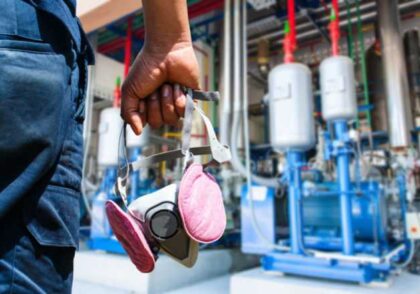زبان تخصصی HSE

زبان تخصصی HSE
در این پست قصد داریم تا به صورت هفتگی با یک تکنیک بسیار کاربردی زبان تخصصی hse شما را به سطح عالی برسانیم.
ما به صورت هفتگی این پست را به روزرسانی خواهیم کرد. و در هر جلسه یک متن تخصصی از کتب HSE و یا سایت های مرتبط با HSE برای شما می آوریم و کلمات تخصصی مربوط به رشته HSE را از آن استخراج می کنیم و در نهایت ترجمه آن متن را هم در اختیارتان قرار می دهیم.
همانگونه که می دانید یکی از روش های متداول در بحث یادگیری زبان و کلمات ، تکرار و بکاربربدن آن در جملات است. و با این روش ما این اطمبنان را به شما می دهیم که در مدت زمان کوتاهی می توانید زبان تخخصی HSE را فرار بگیرید و به راحتی متون تخصصی HSE را ترجمه کنید.
جزوه زبان تخصصی ایمنی صنعتی
Assessment of the Dangerous Toxic Load (DTL).
The DTL describes the exposure conditions, in terms of airborne concentration and duration of exposure, which would produce a particular level of toxicity in the general population
Assessment = ارزیابی
Dangerous = خطرناک
Toxicity = سمیت
Exposure = مواجهه ، در معرض قرار گرفتن
Airborne Concentration = غلظت هوا
Arsenic occurs naturally in the environment as an element of the earth’s crust. Arsenic is combined with other elements such as oxygen, chlorine, and sulfur to form inorganic arsenic compounds. Exposure to higher-than-average levels of arsenic occurs mainly in workplaces, near or in hazardous waste sites, and areas with high levels naturally occurring in soil, rocks, and water.
Arsenic is used in many industries. It is used in some paints, wood preservatives, agricultural chemicals, and in glass manufacturing. Some examples of workers at risk of being exposed to arsenic include: agricultural or farm workers exposed to some farming chemicals, employees involved in glass manufacturing, construction and mine workers exposed to arsenic-containing soil, recyclers exposed to electronic or e-waste, workers who perform nonferrous smelting-a process to extract metal from ore.
Arsenic exposure in the workplace occurs through inhalation, ingestion, dermal or eye contact. Chronic exposure to arsenic leads to distinct skin diseases, such as arsenical keratinosis, which is characterized by excessive formation of scaly skin on the palms and soles; darkened patches of skin; wart formation; skin lesions; acne; and increased risk of skin cancers. Chronic arsenic poisoning can also cause sudden constriction in arteries or veins, reducing blood flow; decreased nerve function; lung, liver, kidney and bladder, and other cancers. Acute exposures can cause lung distress and death. Industries that use inorganic arsenic and its compounds, where sampling may be necessary, include wood preservation, glass production, nonferrous metal alloys, electronic semiconductor manufacturing, and smelter emissions. Arsenic and its compounds occur in crystalline, powder, amorphous, or vitreous forms. National Institute for Occupational Safety and Health (NIOSH) publications Provide a physical description, exposure limits, measurement method, personal protection and sanitation, first aid, respirator recommendations, exposure routes, symptoms, target organs, and cancer sites.
این متن مربوط به کنکور 1402 کارشناسی ارشد مهندسی ایمنی، بهداشت و محیط زیست (HSE) می باشد . که به زودی تحلیل آن را به همراه ترجمه در اختیارتان می گذاریم.




دیدگاهتان را بنویسید